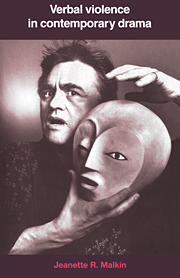2 - Language torture: on Peter Handke's Kaspar
Published online by Cambridge University Press: 26 February 2010
Summary
Die Sprache spricht, nicht der Mensch. Der Mensch spricht nur, indem er geschicklich der Sprache entspricht.
(Language speaks, not man. Man speaks only in so far as he skilfully conforms to language.)This quote from Martin Heidegger might have been written by Peter Handke about his play Kaspar. It concisely sums up Handke's view, or rather critique, of language, and in a voice – controlled, aphoristic, sensitive to the texture and cadence of a well-formed sentence – which is an echo of Handke's own. Kaspar (1968), Handke's first full-length play, is about language and the ways in which the form of language shapes the lives of man. The “story” of the play is that of one speechless man – Kaspar – and how he is created and destroyed through his forced acquisition of language. “The play could also be called speech torture,” Handke writes, thereby making explicit his view of the relationship between language and man: a relationship of torture, pain, and coercion. The play shows, Handke explains, “how someone can be made to speak through speaking.” This is, then, the central “action” of the play: Speech (represented by three disembodied voices, Einsager, i.e. Prompters) creating the Speechless (Kaspar) in its own image. These are also the two main “characters” of the play: Kaspar, a clown figure, a human abstraction whom Handke ironically calls ” the HERO “; and Speech, voices heard over loudspeakers, voices to which Kaspar reacts and with which he is in conflict, voices which teach and finally coerce Kaspar into becoming like speech itself: well-formed and orderly.
- Type
- Chapter
- Information
- Verbal Violence in Contemporary DramaFrom Handke to Shepard, pp. 10 - 37Publisher: Cambridge University PressPrint publication year: 1992



